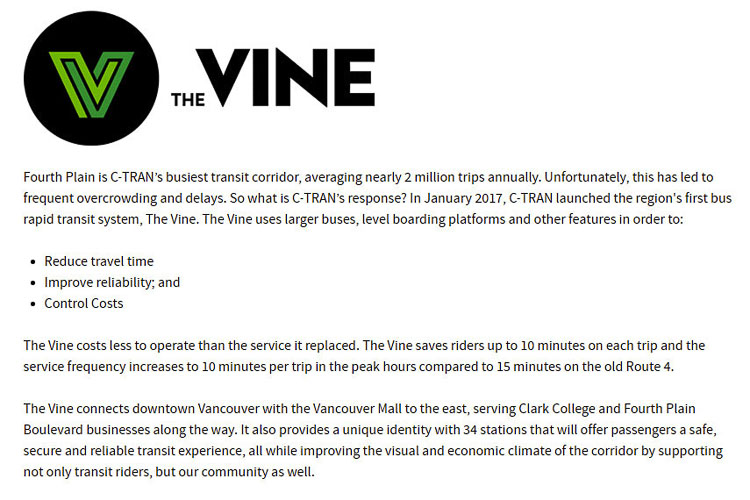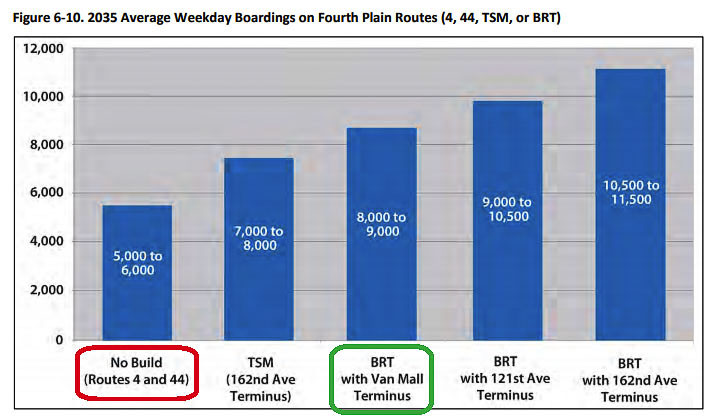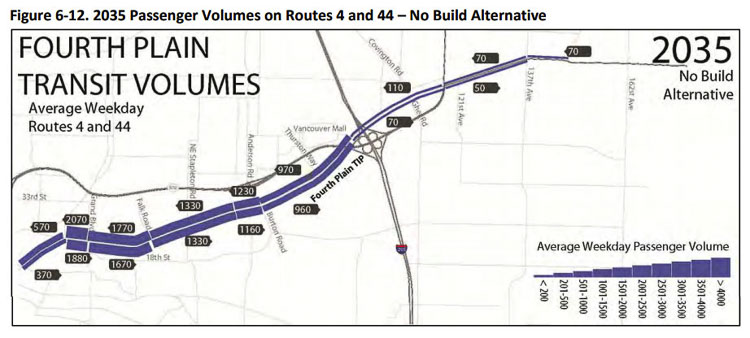C-TRAN forecasted a 50 percent growth in corridor ridership by 2030; instead there is a 33 percent decline
According to C-TRAN, the Fourth Plain corridor is its busiest corridor, averaging “nearly 2 million” trips annually. Officials reported their buses had frequent overcrowding and often experienced delays in getting passengers to destinations.
C-TRAN’s response was to create The Vine, spending $53 million to create its Bus Rapid Transit (BRT) system. It provides faster bus service between Vancouver Mall and downtown by giving buses priority at traffic lights, and reducing the number of bus stops along the 6.7-mile route.
Vancouver resident Bob Housley saw far too many buses running “nearly empty” and decided to investigate. On Thursday morning (June 3), Housley boarded The Vine at 8 a.m. at Todd Road and traveled one complete circuit.
“The most we had was five passengers on those double-buses,” said Housley, not counting himself. He took note of the total passengers and times as the bus departed each stop. The Vine has 17 stops in each direction between downtown Vancouver and Vancouver Mall.
Traveling between two segments from the mall to downtown, there were five passengers on Housley’s bus. Eastbound there were five segments that had five passengers. There were 14 segments with three passengers, eight segments with two passengers, and five segments with four passengers.

C-TRAN purchased 10 “articulated” buses for $1.1 million each that hold nearly twice the capacity of a normal C-TRAN bus. They are 60 feet long and carry up to 100 people with 60 seated, compared to the 40-foot standard bus, which seats 43 people and carries up to 61 passengers.. The articulated buses are low-floor, have three doors, and include three interior bicycle racks according to C-TRAN.
Additionally, passengers purchase their tickets at the bus stop rather than putting cash into the farebox of the bus. This allows them to board faster at all three doors simultaneously.
The Vine replaced two bus routes, (C-Tran routes 4 and 44), that carried over 6,000 passengers daily. Service began on January 8, 2017, using 40-foot buses in place of the service’s articulated buses, and stopping at Route 4 stops rather than Vine stations, due to a winter storm. The articulated buses, which lack drop-down tire chains that would allow for operations in winter conditions, debuted the next day. In its first year of service, The Vine carried 45 percent more riders than Route 4 and operating costs decreased by 21 percent according to C-TRAN.
C-TRAN reports “The Vine costs less to operate than the service it replaced. The Vine saves riders up to 10 minutes on each trip and the service frequency increases to 10 minutes per trip in the peak hours compared to 15 minutes on the old Route 4.”
But The Vine replaced two routes — No. 44 and No. 4. What were the operating costs of each of those routes? Clark County Today has requested information from C-TRAN on the costs of those two routes.
In July 2012, C-TRAN staff told the Board of Directors the following in a staff report, as part of adopting the Locally Preferred Alternative (LPA).
“Transportation demand and transit ridership along Fourth Plain is projected to increase up to 40 percent in the next 20 years due to population and job growth, which will overtake C-TRAN’s ability to adequately serve the Fourth Plain corridor with existing bus service.”
The Purpose and Need statement, adopted in 2011 by the C-TRAN Board stated the following.
“Capacity issues as a result of very high corridor ridership. Some buses are at standing-room-only conditions between 9:00 a.m. and 4:00 p.m. weekdays, and the problem will worsen as ridership increases. There are currently more than 6,000 average weekday boardings on Fourth Plain corridor bus routes; and corridor ridership accounts for approximately one-third of all boardings on the C-TRAN system. Population and employment in the Fourth Plain Study Area are projected to grow by 30 to 40 percent between now and 2035, and downtown Vancouver is expected to grow similarly as well, resulting in projections forecasting a 50 percent ridership increase by 2030, which will significantly exceed transit capacity in the corridor.
A 50 percent growth beyond “6.000 average weekday boardings” by 2030 implies ridership of 9,000 average weekday boardings. That is what was told to the Federal Transit Administration (FTA) in C-TRAN’s request to receive $38.5 million in federal funds.
WSP USA designed the BRT. Prior to this project, two previous fixed local bus routes carried more than 30 percent of C-TRAN’s ridership, they reported. WSP is the firm presently overseeing the Interstate Bridge Replacement Project.
You’ll want to watch this video in full screen mode, preferably on a laptop or computer monitor. There is so much information you may want to watch it twice, to be able to note the number of passengers on each segment, read the text descriptions, and watch the sped up video of the trip on The Vine. Video of bus ride from Bob Housley. Combined graphics by Andi Schwartz
What were The Vine boardings in 2019, prior to the pandemic?
According to C-TRAN, The Vine experienced 1,455,940 total boardings in 2019, a 27 percent decline from the “nearly 2 million” in C-TRAN’s statements. It operated 36,048 hours, carrying 40.39 passengers per hour. A one-way trip on the route takes 24-29 minutes, according to the C-TRAN schedule. Therefore, it’s likely each bus does one round trip per hour, carrying 20 passengers on each of the two legs of it’s journey per hour.
It seems to the average observer that those 20 passengers in each direction could have easily been served by a regular C-TRAN bus, which costs half the price of the $1.1 million articulated buses used on The Vine.
In 2019, C-TRAN spent $5.2 million to operate The Vine, up $103,737 from 2018. The operating cost was $12.97 for each mile The Vine operates.
The Vine was using seven buses in their operation with departures every 10 minutes. During the pandemic, the schedule was reduced to every 12 minutes, using six buses. However C-TRAN purchased 10 of the articulated buses, so that left 30 percent of the fleet idle, not being used prior to the pandemic.
Second BRT line underway
Today, C-TRAN is developing its second BRT line along the Mill Plain corridor. C-TRAN reports it’s the second highest transit ridership route. Another $50 million will be spent to connect a new transit center near Clark College’s Columbia Tech Center campus in east Vancouver with downtown.
“C-TRAN’s current service on the Mill Plain corridor uses, at most, seven or eight buses at any one time throughout the day, operating between downtown Vancouver and the east side of our city,” said Vancouver Mayor Anne McEnerny-Ogle, chair of the C-TRAN Board of Directors. “While ridership has declined during the pandemic, I think we can agree that as we’re beginning to open again, the temporary ridership decline will soon end as well. Regardless, many of our fellow citizens continue to rely on C-TRAN to travel throughout the Mill Plain corridor.”
Among multiple reasons McEnerny-Ogle listed for moving forward with the Mill Plain BRT route, she said the following. “The ability to significantly improve transit travel time and reliability while providing additional capacity to accommodate future ridership growth (which we have also seen with the success of C-TRAN’s BRT service on Fourth Plain).”
Citizens might wonder how far into the future it will take for there to be “ridership growth” that requires the 100-passenger articulated buses. C-TRAN’s experience on The Vine would contradict the “growth” part of the equation. How much would taxpayers want to spend to shave five to 10 minutes off the travel times of mass transit riders? Taxpayers already pay 85 percent of C-TRAN’s operating costs via the sales tax.

In 2020, the FTA announced that it is allocating $24.9 million to the project. The system will replace the existing Route 37 and is expected to begin service in 2023.
McEnerny-Ogle highlighted the following to pay for the Mill Plain BRT.
The following is the most recent breakdown received from C-TRAN for the estimated $49.8 million project:
• $24.9 million Federal Transit Administration Small Starts Grant
• $5 million Federal CMAQ funding
• $3.7 million Federal American Rescue Plan funding
• $9 million Washington State Regional Mobility Grant
• $7.2 million C-TRAN local share (less than 15 percent of the total project cost)
McEnerny-Ogle shared they expect to run the Mill Plain BRT articulated bus service every 15 minutes, Current Route 37 service is generally four buses an hour at staggered times.
Additionally, they have plans for a third BRT line connecting the Hazel Dell area with downtown along Highway 99.
C-TRAN told the FTA they expect the Mill Plain BRT to carry 3,100 “daily linked trips” with an annual operating cost of $1.47 million. Assuming most passengers travel two ways, C-TRAN would be serving 1,550 people with the $50 million expenditure. The 3,100 boardings are half the “more than 6,000” trips the FTA was told The Vine would serve.
Has The Vine met the forecast?
In their request to the FTA, C-TRAN officials said via their Purpose and Need statement that “some buses are at standing-room only conditions between 9 a.m. and 4 p.m. weekdays.” They indicated based on C-TRAN’s experience, these carry approximately 45 to 55 passengers (both seated and standing).
The Sept. 15, 2015 FTA press release stated: “With the opening of the Vine, bus ridership in the corridor is expected to increase to 5,800 average weekday trips. The rapid bus will run every 10 minutes during rush hour and every 15 minutes during off-peak times.” Today, The Vine runs every 12 minutes for 12 hours a day, one less bus per hour.
C-TRAN also forecast a 50-percent ridership increase by 2030, according to the Purpose and Need statement from 2011.
In 2019, Vine ridership averaged 3,989 according to C-TRAN. That’s a 33 percent drop from 2011 numbers, and that was before the pandemic.
Furthermore, it is now halfway to 2030 when C-TRAN predicted 9,000 average weekday boardings. C-TRAN is 55 percent short of their projection, having “lost” over 2,000 average weekday passengers from when they asked the FTA to fund the BRT project.

Two routes operated on Fourth Plain where The Vine now runs — Routes 4 and 44. How many passengers did they carry on an average weekday, prior to The Vine beginning operations in January 2017?
Route 4 carried the majority of passengers. It served 6,486 passengers on an average weekday in 2014, 6,088 in 2015, and 4,919 in 2016 according to information provided by C-TRAN. That’s a 24 percent decline in ridership in just three years, prior to starting The Vine.
Route 44 carried less than 10 percent of the passengers Route 4 carried. The Route 44 service carried 433 passengers on an average weekday in 2014, 408 in 2015, and 287 in 2016.
With 5,206 total passengers in 2016, C-TRAN had already “lost” 800 Fourth Plain passengers on an average day prior to the opening of The Vine.
C-TRAN officials informed the FTA it would increase ridership compared to both lines by 50 percent. Instead, ridership has declined by roughly 33 percent, from 6,000 to 3,989.
How far into the future will it take for there to be “ridership growth” on the Mill Plain BRT route that requires the $1.1 million, 100-passenger articulated buses? C-TRAN’s experience on The Vine would contradict the “growth” part of the equation.
C-Tran carries 22 people per hour
The 2019-2024 Transit Development Plan states that on its “fixed route” bus system, C-TRAN carried an average of 21.6 passengers per hour in 2018. It has 28 numbered routes in addition to The Vine and The Connector, 30 in total.
C-TRAN spent $7.28 in operating costs for each passenger in 2019, an increase from $6.98 a year earlier. Over 11 percent of vehicle operating hours were not in revenue service, (277,789 vs. 308,622).
But if C-TRAN’s fixed route costs (including The Vine) in 2019 were $7.28 for each passenger in 2019, how does that compare to The Vine’s costs for each passenger? According to C-TRAN, The Vine cost was half that, or $3.57 per passenger.

But keep in mind that The Vine had 1.45 million passenger boardings in 2019. That is 24 percent of all C-TRAN boardings on just one of their 30 routes. That would imply a lot of empty buses are running on the rest of the 29 fixed routes that C-TRAN operates.
McEnerny-Ogle closed with the following optimistic statement.
“I’m confident that C-TRAN’s Mill Plain BRT Project will be yet another example of a successful project for both transit riders and other users of the corridor (cars, bikes and pedestrians) as well as businesses, education and health-care facilities that are located along the corridor. I’m looking forward to seeing construction begin later this year!”
Housley’s observation was that The Vine appeared to be running at about 4 percent of their capacity. “Carrying three or four people in a 100 passenger bus makes no sense to me,” he said. “C-TRAN does a fine job at ‘hauling air.’’’
“Our normal 60-passenger (43 seat) buses will more than adequately serve the demand for transit,” Housley said. “What private business buys an asset and only uses four percent of the capacity of that asset?”
What’s up and what’s down?
In 2011, when C-TRAN began its journey towards creating BRT, it had 6.7 million passenger boardings. By 2019, the number had declined 10.9 percent to 5.9 million boardings. Passenger miles declined 12.4 percent from 33.7 million miles to 29.5 million miles. Operating revenue (passenger fares) declined 15 percent from $7.29 million to $6.2 million.
In 2011, operating costs were $29.9 million. In 2019, they climbed 45 percent to $43.6 million. Operating hours increased 9.2 percent. The cost per passenger mile increased 65 percent. The cost per boarding passenger increased 63.6 percent from $4.45 to $7.28.
In spite of 734,000 fewer boardings in 2019 compared to 2011, C-TRAN increased its number of buses from 108 to 122 vehicles.
C-TRAN’s employees have also grown over 20 percent, from 384 in 2011 to 464 in 2019.




